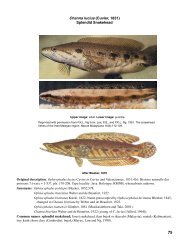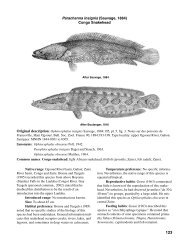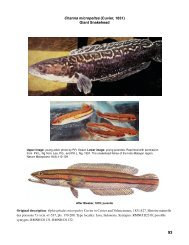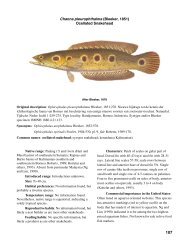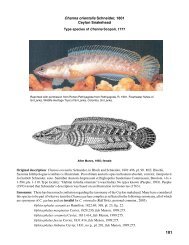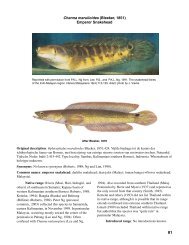Invasive Species ProgramâSnakeheads, Aquatic Invaders
Invasive Species ProgramâSnakeheads, Aquatic Invaders
Invasive Species ProgramâSnakeheads, Aquatic Invaders
Create successful ePaper yourself
Turn your PDF publications into a flip-book with our unique Google optimized e-Paper software.
natural waters of the U.S. may have been<br />
released by aquarium hobbyists or those<br />
hoping to establish a local food resource.<br />
Also, some cultures practice “prayer<br />
animal release,” a faith-based activity in<br />
which individuals purchase, then release,<br />
an animal (fish, amphibian, reptile, or<br />
bird) to earn merits with a deity.<br />
What are the potential effects to<br />
our waters<br />
During all life stages, snakeheads<br />
compete with native species for food and<br />
habitat. As juveniles, they eat zooplankton,<br />
insect larvae, small crustaceans, and<br />
the young of other fishes. As adults, they<br />
become voracious predators, feeding on<br />
other fishes, crustaceans, frogs, small<br />
reptiles, and sometimes birds and small<br />
mammals. Should snakeheads become<br />
established in North American ecosystems,<br />
their predatory behavior could drastically<br />
disrupt food webs and ecological<br />
conditions, thus forever changing native<br />
aquatic systems by modifying the array<br />
of native species.<br />
An additional concern is the snakehead’s<br />
potential to transfer pathogens to<br />
native fishes, because snakeheads can<br />
carry diseases and parasites that have the<br />
potential to be harmful. Fishery scientists<br />
need to study this potential to determine<br />
if diseases and parasites can be transferred<br />
to North American species.<br />
Have snakeheads been<br />
introduced to places other than<br />
the United States<br />
Northern snakeheads were purposefully<br />
introduced and established into<br />
Japan in the early 1900s. They were<br />
introduced into parts of the former Soviet<br />
Union (Kazakhstan, Uzbekistan, Turkmenistan)<br />
when accidentally mixed with<br />
shipments of imported Asian carps. This<br />
fish also became established in Russia<br />
for a short time in the 1950s and was<br />
successfully introduced into Czechoslovakia.<br />
The blotched snakehead was successfully<br />
introduced into the Philippines<br />
and into Madagascar where it is now<br />
a major threat to many of the endemic<br />
cichlid fishes of that island nation.<br />
The chevron snakehead (Channa striata)<br />
was successfully introduced into the<br />
Philippines, is reported to be established<br />
in other Pacific islands, and is being<br />
cultured in Hawaii.<br />
Do snakeheads “walk”<br />
Although claims of their mobility have<br />
been greatly exaggerated, several species<br />
of snakeheads are able to wriggle overland<br />
from one body of water to another,<br />
particularly if the ground is wet. They do<br />
this by flexing their body and pushing<br />
with their tail, while using their broad<br />
pectoral fins to stabilize their head. It is<br />
unknown how far they can travel on land.<br />
This crawling ability is reduced in larger<br />
species of snakeheads as they reach adulthood.<br />
The introduced blotched snakehead<br />
in Madagascar is known to crawl<br />
onshore, allow its body to be covered<br />
with ants, then return to the water where<br />
the ants are dislodged and subsequently<br />
eaten by the fish.<br />
How many eggs do snakeheads lay<br />
A mature northern snakehead female<br />
can carry as many as 50,000 eggs,<br />
although some will not develop and<br />
others will be eaten by insects and small<br />
fishes following fertilization. Depending<br />
on water temperature, eggs can hatch in<br />
about 24-48 hours. When the fry hatch,<br />
they remain clustered at the surface of the<br />
nest until their fins develop. At that time,<br />
the young (early juveniles) begin swimming<br />
by diving down into the center of<br />
the nest, then rising back to the surface.<br />
Early juveniles remain in the nest for<br />
3-4 weeks, schooling, and being guarded<br />
by one or both parents. All species of<br />
snakeheads guard their eggs and young, a<br />
behavior that is rare in our native fishes.<br />
Juvenile snakeheads (fry) cluster at the<br />
surface of their “nest,” a column of water<br />
cleared from vegetation in 2-3 feet of water.<br />
Their parents will aggressively guard their<br />
nest for 3-4 weeks while the fry develop their<br />
fins, learn to school, and are ready to fend for<br />
themselves.



